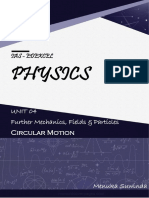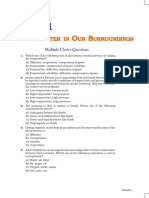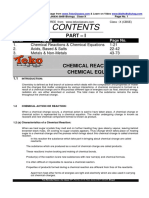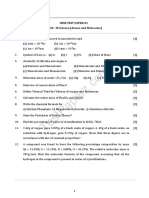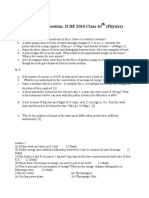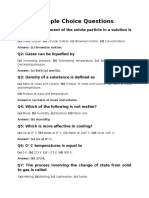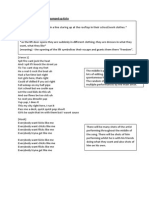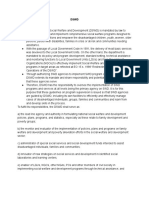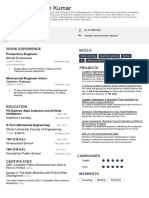LATENT HEAT
Latent Heat and Specific Latent Heat
Latent heat is “hidden heat”. That changes the state of an object without causing a
temperature change. For example: Latent heat changes ice at 0 °C to water at 0 °C.
Latent Heat of Fusion (L)
The latent heat of fusion of a solid is the heat required to change a solid to a liquid
without a temperature change.
latent heat of fusion = heat energy needed to melt all of it.
L = EH
Units: Joules (J)
Specific Latent Heat of Fusion (ℓf )
The specific latent heat of fusion of a solid is the heat required to change 1kg of it, from a
solid to a liquid without any temperature change.
specific latent heat of fusion = heat energy / mass
ℓf = EH / m
Units: J/kg
We can rearrange this formula, to obtain a formula for heat energy:
heat energy = mass × specific latent heat of fusion
EH = m ℓf
�LATENT HEAT
Latent Heat of Vaporization (L)
The latent heat of vaporization of a liquid is the heat required to change a liquid to a gas,
without a temperature change.
Specific Latent Heat of Vaporization ( ℓv )
The specific latent heat of vaporization of a liquid is the heat required to change 1kg of it,
from a liquid to a gas without any temperature change.
Heat Formulas
We now have two formulas to use to determine the heat energy:
(i) EH = mc∆T (this heat energy causes a change of temperature)
(ii) EH = m ℓf (this heat energy causes a change of state, but no temperature
change)
Examples:
1. Calculate the quantity of heat required to melt 5 kg of ice and then raise the
temperature of the water formed to 30 o C. Use specific latent heat of fusion of ice
= 336 000 Jkg-1.
2. An ice lolly has a mass of 100g, if the specific latent heat of fusion of ice is 340
000J / kg; calculate the amount of heat needed to melt the lolly.
�LATENT HEAT
3. Calculate the heat energy required to convert 4 kg of ice at -25°C, to stem, at
100°C, given that specific heat capacity of water is 4 200J/(kg°C), the specific
heat capacity of ice is 2 100J/(kg°C), the specific latent heat of fusion of ice is
340 000J/kg, and the specific latent heat of vaporization of water is 2 300 000J/k
How to determine the specific latent heat of fusion of ice.
Find the mass of a clean dry polystyrene cup with a drinking straw (used as a stirrer).
Half-fill the cup with water that has been previously warmed to 15 o C above room
temperature. Determine the new mass of the cup with the water and straw and hence
measure the mass of the water in the cup, mw.
When the temperature of the water is about 10 o C above room temperature (accurately
measured with a thermometer, while stirring), start adding small pieces of ice, previously
dried on a tissue to remove the water. Add one piece at a time and stir until all the ice is
melted before adding another piece. Keep repeating this until the final water temperature
is about 10 oC below the room temperature. Record this temperature.
Next, weigh the cup with cold water to find the total mass and thus the mass, m1 of the
ice melted.
The changes taking place are:
Ice → water at 0oC (change of state, so temperature is constant)
Water at 0 oC → water at Tf oC (change of temperature of water = Tf)
Water Ti → water Tf (where Ti = initial temperature of water in cup and Tf = final
temperature of water in cup).
While the ice gains heat and melt, the water and calorimeter are both losing the same
amount of heat. (Conservation of energy principle)
Heat loss by water = mw cw ∆Tw = mw cw (Ti – Tf)
Heat gained by ice and water formed from it = mi ℓ + mi cw (Tf - 0)
Heat gained by ice + heat gained by water from it = Heat lost by water originally in the cup
mi ℓf + mi cw (Tf - 0) = mw cw (Ti – Tf)
By substituting for mw cw Ti and Tf the value of ℓf may be found.
NOTE:
1. The ice should be dried properly with tissue paper before placing it in water.
2. When the water and calorimeter are 10 oC above room temperature the heat lost
(mainly by radiation) at temperatures above room temperature is compensated for
by adding enough ice to cool the temperature down to 10 oC below room
temperature, when heat is now gained from the surroundings.
3. The water and ice must be stirred to achieve a uniform temperature.
�LATENT HEAT
Example:
Use the sample data given to determine the specific latent heat of fusion of ice.
Mass of empty cup = 23g
Mass of cup and ‘room temperature water’ = 123g
Initial temperature of ‘room temperature water’ = 17oC
Final temperature ‘chilled water and molten ice’ = 5oC
Total mass of cup, water and molten ice at end = 139g










